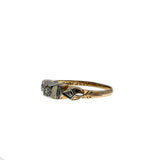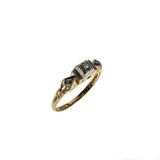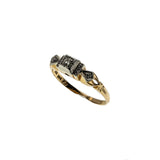Most associate milgrain with the Art Deco period when it was at the height of its popularity for modern times. This is when it got its name, which is derived from the French ‘mille-grain’ and translates to “a thousand grains.” But this design technique dates back many centuries, originating in Southeast Asia. Among artifacts excavated from ancient sites of this region, earrings were the first items discovered featuring milgrain. Later, many examples of rings with a milgrain design were revealed.
The technique continued to be developed and spread, but did not become widely popular until the Edwardian Era of the very early 20th century. Milgrain was seen as a delicate, finely detailed, ornamental element that perfectly suited the wealth and excess of the time. Platinum was the metal of choice for fine jewelry, and the invention of the acetylene torch allowed skilled jewelers to create stunning designs with milgrain as a main feature.
The Art Deco period that followed saw milgrain become more available to the masses as jewelers incorporated the technique with white gold jewelry pieces. The popular and exciting geometric designs of the day highlighted clean lines that were well-suited to using milgrain. It is during this period that milgrain became heavily associated with engagement rings and wedding bands.
There are three methods by which milgrain is achieved on a piece of jewelry. Two of them are long-held traditional techniques that require the skill of master craftsmen. These two techniques have only seen the very recent addition of a third technique with the advent of technology and computer-aided design, or CAD.
In the first method that dates back to the earliest milgrain creations, each tiny bead is crafted by hand and then individually placed in the design and hand-soldered to fuse together. This method is extremely time-consuming and requires painstaking levels of attention to detail and expert precision. For many, the added level of care and time spent on an engagement ring or wedding band with milgrain translates into a lovely romantic sentiment.
The second method features the use of a custom tool called a knurling tool. Imagine a much smaller pizza cutter and you can envision the knurling tool. The wheel part of the tool is called the milgrain wheel. Most often the wheel features a round milgrain pattern as that is the most widely used design. But wheels are designed with oval or square milgrain as well and can come in various sizes.
To achieve the milgrain using the knurling tool, the wheel is placed on the metal edges and rolled carefully along the border. Small bumps or dots of milgrain become engraved in the metal creating the desired milgrain look and texture.
The modern third method is most often accomplished through the use of 3D-CAD computer software. Jewelers can design a milgrain effect for a piece of jewelry within the program, which then sends it to a printer to produce a wax mold. That wax mold is then cast in metal die form. This is certainly the most efficient method although it lacks much of the appeal that the care and expert craftsmanship of the first two methods brings.





















